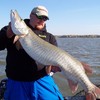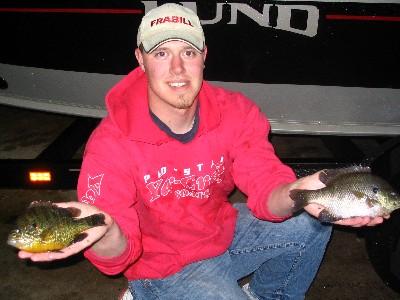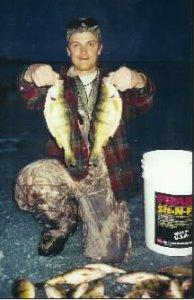Panfish are one of the most popular species of fish pursued by anglers, and for good reason; they're plentiful, tasty, and more often than not, willing to bite. Our waters here in the North-Central Wisconsin area are home to excellent bluegill and crappie fishing, and the bite' occurs all year long. Here in the final weeks of the ice-fishing season, many anglers will cash in on some of the best hard-water action of the year; here are a few tips to help you become one of those fishermen.
1. Green is gold':
Successful ice fishermen targeting walleyes and northern pike know that finding areas of green weeds often means finding the areas consistently holding more and bigger fish; the same holds true for bluegills. Finding green weeds in winter, especially during late winter, can be a challenge. This will often require an angler to drill several holes in different locations to locate the prime' spots. If you are bringing up dead brown weeds, move it will be worth it.
2. Size does matter:
While many a crappie or bluegill is caught during summer on or even 3/8 ounce jigs by walleye fishermen, the wintertime is a different story. Make sure to have an array of not only styles and colors, but sizes as well. Jigs with size 10, 12, and 14 are ideal for finicky panfish during the cold-water months. Often during a tough bite, downsizing your presentation can make a big difference. In addition, be sure to use a sensitive rod to detect light bites; models by Frabill and St. Croix are excellent choices.
3. Knock on wood:
The rivers and flowages of our area are littered with stumps, logs, and blow-downs of all sorts. While green weeds are excellent bluegill habitat, wood structure will also hold bluegills, as well as crappies, perch, and other species. Locating good areas to fish is often done during summer through the use of your boats electronics or by locating likely areas visually; mark these areas on your GPS or map to be able to find them again during winter. Once the water is frozen or if you were unable to do your homework' on a particular body of water, you can also analyze the shoreline, especially if there is a sharper break to it; look for logs, stumps, and the like that may hint at good wood cover located there.
4. Mix it up:
There are a variety of live bait selections to choose from when ice-fishing for panfish; wax worms, spikes, mousies, and mealworms are a few of the more popular. As carrying an assortment of jigs is important, it pays it carry an assortment of live bait as well. You may be very surprised how fickle our finned friends can be. Many an ice-fishing outing has been "saved" by experimenting to find the "hot" live bait choice. If you don't bring an assortment with, you leave yourself with limited options should the fish change their minds.




